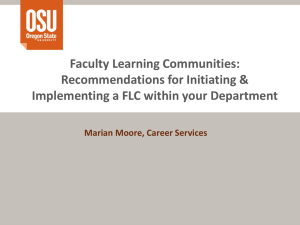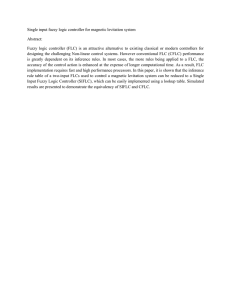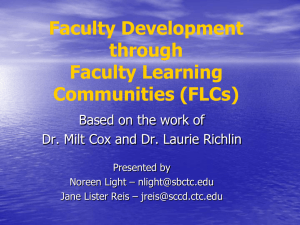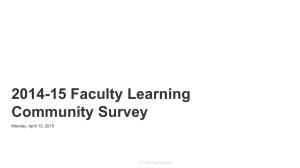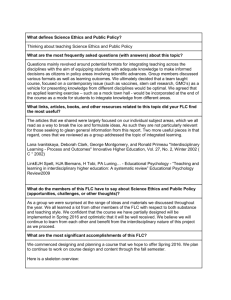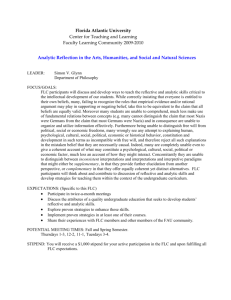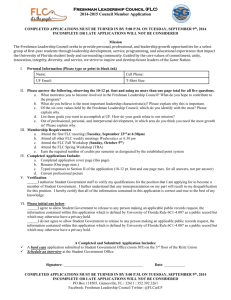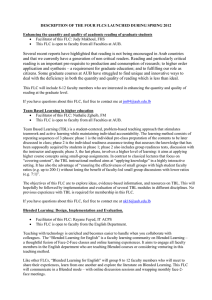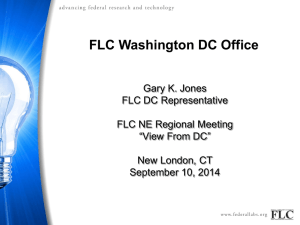Faculty Learning Community Descriptions Spring 2015 What is a
advertisement
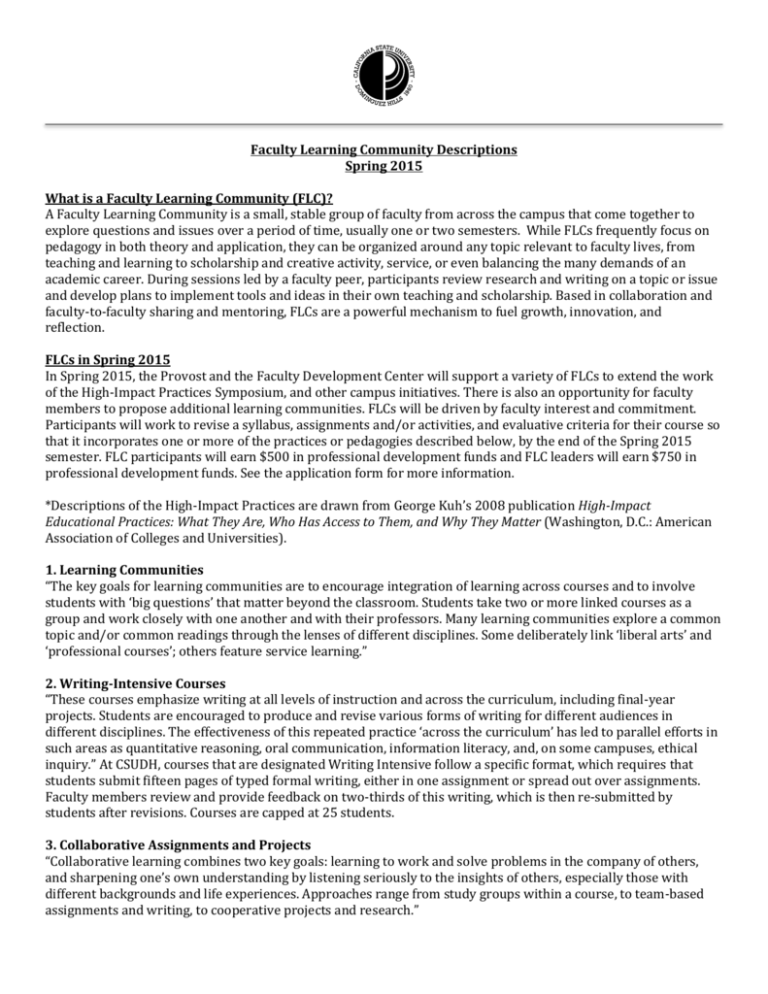
Faculty Learning Community Descriptions Spring 2015 What is a Faculty Learning Community (FLC)? A Faculty Learning Community is a small, stable group of faculty from across the campus that come together to explore questions and issues over a period of time, usually one or two semesters. While FLCs frequently focus on pedagogy in both theory and application, they can be organized around any topic relevant to faculty lives, from teaching and learning to scholarship and creative activity, service, or even balancing the many demands of an academic career. During sessions led by a faculty peer, participants review research and writing on a topic or issue and develop plans to implement tools and ideas in their own teaching and scholarship. Based in collaboration and faculty-to-faculty sharing and mentoring, FLCs are a powerful mechanism to fuel growth, innovation, and reflection. FLCs in Spring 2015 In Spring 2015, the Provost and the Faculty Development Center will support a variety of FLCs to extend the work of the High-Impact Practices Symposium, and other campus initiatives. There is also an opportunity for faculty members to propose additional learning communities. FLCs will be driven by faculty interest and commitment. Participants will work to revise a syllabus, assignments and/or activities, and evaluative criteria for their course so that it incorporates one or more of the practices or pedagogies described below, by the end of the Spring 2015 semester. FLC participants will earn $500 in professional development funds and FLC leaders will earn $750 in professional development funds. See the application form for more information. *Descriptions of the High-Impact Practices are drawn from George Kuh’s 2008 publication High-Impact Educational Practices: What They Are, Who Has Access to Them, and Why They Matter (Washington, D.C.: American Association of Colleges and Universities). 1. Learning Communities “The key goals for learning communities are to encourage integration of learning across courses and to involve students with ‘big questions’ that matter beyond the classroom. Students take two or more linked courses as a group and work closely with one another and with their professors. Many learning communities explore a common topic and/or common readings through the lenses of different disciplines. Some deliberately link ‘liberal arts’ and ‘professional courses’; others feature service learning.” 2. Writing-Intensive Courses “These courses emphasize writing at all levels of instruction and across the curriculum, including final-year projects. Students are encouraged to produce and revise various forms of writing for different audiences in different disciplines. The effectiveness of this repeated practice ‘across the curriculum’ has led to parallel efforts in such areas as quantitative reasoning, oral communication, information literacy, and, on some campuses, ethical inquiry.” At CSUDH, courses that are designated Writing Intensive follow a specific format, which requires that students submit fifteen pages of typed formal writing, either in one assignment or spread out over assignments. Faculty members review and provide feedback on two-thirds of this writing, which is then re-submitted by students after revisions. Courses are capped at 25 students. 3. Collaborative Assignments and Projects “Collaborative learning combines two key goals: learning to work and solve problems in the company of others, and sharpening one’s own understanding by listening seriously to the insights of others, especially those with different backgrounds and life experiences. Approaches range from study groups within a course, to team-based assignments and writing, to cooperative projects and research.” 4. Undergraduate Research “Many colleges and universities are now providing research experiences for students in all disciplines. Undergraduate research, however, has been most prominently used in science disciplines...The goal is to involve students with actively contested questions, empirical observation, cutting-edge technologies, and the sense of excitement that comes from working to answer important questions.” At CSUDH, the idea for Undergraduate Research is broad and includes research, scholarship, and creative activities. 5. Diversity/Global Learning: General “Many colleges and universities now emphasize courses and programs that help students explore cultures, life experiences, and worldviews different from their own. These studies—which may address U.S. diversity, world cultures, or both—often explore ‘difficult differences’ such as racial, ethnic, and gender inequality, or continuing struggles around the globe for human rights, freedom, and power. Frequently, intercultural studies are augmented by experiential learning in the community and/or by study abroad.” 6. Service Learning, Community-Based Learning “In these programs, field-based ‘experiential learning’ with community partners is an instructional strategy—and often a required part of the course. The idea is to give students direct experience with issues they are studying in the curriculum and with ongoing efforts to analyze and solve problems in the community. A key element in these programs is the opportunity students have to both apply what they are learning in real-world settings and reflect in a classroom setting on their service experiences. These programs model the idea that giving something back to the community is an important college outcome, and that working with community partners is good preparation for citizenship, work, and life.” 7. Internships “Internships are another increasingly common form of experiential learning. The idea is to provide students with direct experience in a work setting—usually related to their career interests—and to give them the benefit of supervision and coaching from professionals in the field. If the internship is taken for course credit, students complete a project or paper that is approved by a faculty member.” 8. Capstone Courses and Projects “Whether they’re called ‘senior capstones’ or some other name, these culminating experiences require students nearing the end of their college years to create a project of some sort that integrates and applies what they’ve learned. The project might be a research paper, a performance, a portfolio of ‘best work,’ or an exhibit of artwork. Capstones are offered both in departmental programs and, increasingly, in general education as well.” 9. Diversity/Global Learning: Study Abroad In this FLC, participants will explore the research, pedagogy, and planning necessary for faculty-led study abroad experiences, with particular attention to the ways in which study abroad, usually short-term, helps students learn experientially in places where they explore “cultures, life, experiences, and worldviews different from their own.” 10. Local History as Pedagogy: The Watts Rebellion In this FLC, participants will explore ways in which to incorporate the Watts Rebellion of 1965 into their courses. As a central event that influenced the establishment of CSUDH in Carson, study of the Watts Rebellion in a variety of disciplines provides a forum where students analyze the variety of ways in which a local historical event has meaning in their own lives. 11. Affordable Learning Solutions This FLC will explore ways in which faculty can utilize low and no-cost learning resources in their courses. The resources can range from e-book editions to resources in the CSU Electronic Core Collection journal databases to online educational resources (OERs). A major thrust of the AL$ initiative is to encourage faculty to find OER materials in MERLOT, the largest multimedia educational resources for learning and online teaching. 2
